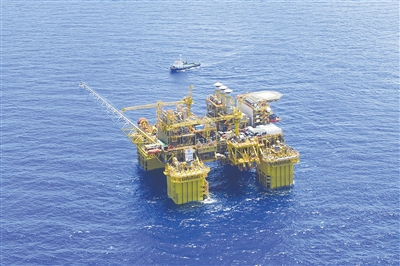
 SCIENCE KNOWS NO BORDERS
SCIENCE KNOWS NO BORDERS Science as A Bridge to Benefit Global Well-being
Science as A Bridge to Benefit Global Well-being International Lunar Research Station Built by 2035
International Lunar Research Station Built by 2035 Exploring Energy Supplies and Secrets Far Beneath the Sea
Exploring Energy Supplies and Secrets Far Beneath the Sea Optimum Astro-observation Base Built on Qinghai-Tibet Plateau
Optimum Astro-observation Base Built on Qinghai-Tibet Plateau More COVID-19 Antigen Self-test Kits Approved
More COVID-19 Antigen Self-test Kits Approved WEEKLY REVIEW
WEEKLY REVIEW RCEP Effective in Malaysia
RCEP Effective in Malaysia WECHAT ACCOUNT
WECHAT ACCOUNT E-PAPER
E-PAPER
 |
| The "Deep Sea No.1" energy station at the Lingshui 17-2 gas field off south China's island province of Hainan. (PHOTO: XINHUA) |
The natural gas generated by Deep Sea No.1, China's first self -operated, 1500-meter, ultra-deep-water gas field, reached more than one billion cubic meters recently after the gas field was put into operation last June. Despite being a late comer in exploration for petroleum and natural gas in deep water, China has managed a quick catch up.
Deep water drilling and exploration
The deep water zone usually refers to water deeper than 300m, and ultra-deep water zone deeper than 1500m. More than 70 percent of the global petroleum and natural gas reserves lie under the sea, and around 40 percent of the reserves are in deep water, which makes deep water drilling and exploration extremely important.
Located 150km to the southeast of Sanya, Hainan province, Deep Sea No.1 is expected to hold an energy reserve of more than 100 billion cubic meters. However, because the gas field is in such deep water, the process of exploration and extraction faces many challenges.
Deep Sea No.1 is also the world's first 100,000-ton class deep water semi-submersible platform for producing and storing petroleum and natural gas. With self-developed technologies for the past 20 years, China overcame three major technical problems, namely deep water, high temperature and high pressure in petroleum and natural gas exploration.
Now, it takes only one day for the natural gas to be extracted from the 1500m-deep water and sent to households, and the gas field is able to deliver three billion cubic meters of natural gas per year to south China's Guangdong and Hainan provinces and Hong Kong.
With its system of technologies for such exploration, China has now become one of the few countries that are able to independently explore petroleum and natural gas in deep water.
Deep-sea diving
Apart from extracting fossil fuels from the sea, people also go deeper to explore the mysteries of the Earth, since oceans deeper than 2,000 meters cover 60 percent of the planet. It was through manned deep diving that China discovered polymetallic nodules on the seamount, the ancient hydrothermal district and cold water coral forests in the South China Sea.
In 1986, the country's first manned submersible was developed, only able to dive to a depth of 300 meters. More than 20 years later, the self-designed Jiaolong came into being in 2012, successfully diving as deep as 7,062 meters.
On November 10, 2020, the domestically -developed Fendouzhe dived in the Mariana Trench in the Western Pacific, reaching 10,909 meters, setting a new record for China's manned deep-sea diving. This means that China leads the world in the field of large-depth manned deep-sea diving.
The country has also had much progress in unmanned submersibles for deep-sea diving.
See page 2
In October 2021, the Shenyang Institute of Automation, Chinese Academy of Sciences announced that the unmanned submersible Haidou-1 completed the world's first full-coverage acoustic cruise of the western depression of the Challenger Deep, which is the deepest region of the ocean at a depth of 10,908 meters.
Underwater observation networks
Haidou-1 worked for more than 10 hours continuously under the water at 10,000 meters. Despite reaching a world-leading levle, ten hours is still not long enough to explore the secrets of the sea. Underwater networks for long term observation are essential for further ongoing exploration.
Since the 1990s, scientists have begun to put sensors on seabeds, connected the sensors with optical cables and transited information to the surface. The networks can conduct long-term monitoring free from the impact of typhoons or earthquakes. Such networks can act as weather stations and laboratories, uplifting the capability of ocean observation.
An important application of an underwater observation network is to give warnings for earthquakes and tsunamis. Eighty five percent of volcanoes in the world are underwater. The facilities set up on seabeds could monitor the eruption of volcanoes in real time.
In 2005, China began to promote the construction of underwater observation networks. After 12 years, the national underwater observation network was authorized to be built, aiming to conduct comprehensive monitoring from seabed to sea surface in all weather, real time and in high definition.
Despite the work scientists have done, a great many questions about the sea or related to it remain unsolved. Deep-sea exploration will still be a crucial approach to help humans discover more secrets about nature and human life.

 Next
Next



